| | In-field variation | Saline soils | Acid soils | Peat soils | Solonetzic soils | Soil compaction | Marginal crop lands
In-field Variation
Site-specific management or precision farming is the practice of tailoring farm inputs according to differences in growing conditions within farm fields. It offers the potential to increase economic efficiency and reduce environmental impacts. For example, a uniform fertilizer rate results in overapplication in areas where yields are limited by other factors, such as on eroded knolls, and in areas where nutrient levels are already high. Overapplication increases the risk of nutrient losses to the environment and such problems as crop lodging. Site-specific management allows producers to apply inputs only where they are needed.
Site-specific management can also be used to limit inputs in areas prone to loss of that input. An example is reducing nitrogen applications to low-lying areas that are periodically saturated. In wet conditions, nitrogen is easily lost to the atmosphere as nitrous oxide, a greenhouse gas, harming the environment and reducing the nitrogen available to the crop.
There are many inexpensive tools to aid site-specific management. These include soil sampling at benchmark locations to represent different site conditions (see Soil Sampling and Testing), air photo interpretation to identify the extent of different soils or landform units that should be managed differently, and variable rate controllers to change input rates.
More costly options include global positioning system (GPS) tools to locate soil and yield sample areas, yield monitors to measure yield variation, and geographic information system (GIS) software and other software tools to map crop and soil information. Whether these tools are economically justified will depend on the specifics of your operation.
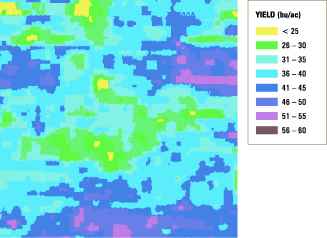
Yield map showing yield variation within a sample field.
Courtesy of ARD

Tractor mounted with GPS to locate soil and yield sample areas.
Courtesy of AgTech Centre - ARD
- For more information, see PFRA's Questions and Answers on Precision Farming.
Saline Soils
Agricultural practices can play a role in increasing or decreasing saline seeps. Practices to manage soil salinity include:
- Test soil samples from the area suspected of having excess salts to determine whether you have saline, saline-sodic, sodic soils or some other condition (see Soil Salinity).
- Contact a soil specialist to identify existing and potential recharge areas and to develop a plan for controlling salinity.
- In recharge areas:
- Use deep-rooted, high-moisture-use crops like alfalfa. These crops help dry out the subsoil and lower the water table so less water and salt move from the recharge area to the discharge area.
- Avoid summerfallowing these areas.
- Use grassed waterways to remove excess water.
- Use snow management to evenly distribute snow and prevent ponding in the spring.
- In discharge areas:
- As much as possible, have growing plants in the discharge area to help lower the water table. Use continuous cropping if possible (see Table 2.2), or convert the area to permanent cover with salt-tolerant grasses (see Table 3.7).
- Consider using subsurface (tile) drainage systems to remove water and salts from the seep. Although subsurface drainage is expensive, not suited to all salinity types and requires engineering design, it will lower water tables in seeps if the conditions are right, and the system is properly designed, installed and managed.
- Avoid applying manure to this area because manure contains salts.
- Monitor the extent and intensity of the saline areas over time. If they continue to grow, consider increasing control measures. For example, convert a greater portion of the land around the recharge area into deep-rooted perennial forages.
Table 3.7 Grass species recommended for seeding into saline seeps
| Species | Seeding Rate (kg/ha) | Rate of Establishment | Sod or Bunch | Salinity Tolerance* | Longevity | Winter Hardiness | Flooding Tolerance | Drought Tolerance |
| Creeping Foxtail | 5 - 10 | Average | Sod | High | Long | Good | High | Poor |
| Meadow Foxtail | 5 - 10 | Average | Sod | Medium | Long | Good | High | Poor |
| Smooth Bromegrass | 5 - 10 | Slow | Sod | Medium | Long | Excellent | Medium | Good |
| Meadow Bromegrass | 5 - 10 | Slow | Sod | Medium | Long | Excellent | Medium | Good |
| Slender Wheatgrass | 5 - 10 | Very Fast | Bunch | High | Short | Good | Medium | Good |
| Intermediate Wheatgrass | 5 - 10 | Fast | Sod | Medium | Short | Excellent | Medium | Good |
| Pubescent Wheatgrass | 5 - 10 | Fast | Sod | Medium | Short | Excellent | Medium | Good |
| Tall Wheatgrass | 5 - 10 | Fast | Bunch | High | Long | Excellent | High | Poor |
| Western Wheatgrass | 5 - 10 | Fast | Sod | High | Long | Excellent | High | Good |
| Russian Wildrye | 5 - 10 | Very Slow | Bunch | High | Long | Good | Poor | Good |
| Altai Wildrye | 5 - 10 | Very Slow | Bunch | High | Long | Excellent | Medium | Good |
| Beardless Wildrye | 5 - 10 | Very Slow | Sod | Very High | Long | Good | Medium | Good |
| Nuttall’s Alkali Grass | 5 - 10 | Average | Sod | Very High | Long | Good | Medium | Good |
* Salinity tolerance: medium - tolerates up to 6 to 8 dS/m; high-tolerates up to 8 to 12 dS/m; very high - tolerates greater than 12dS/m.
Source: Wentz, D. 1997. Perennial Crops for Salinity Control in Discharge Areas. Alberta Agriculture, Food and Rural Development, Agdex 518-1.
Acid Soils
Acid soils can occur naturally or as a result of the long-term use of nitrogen fertilizers. To manage these soils, follow these guidelines:
- Sample and soil test to find out the extent and severity of soil acidity, determine the rate of lime required, and obtain an estimate of crop response to lime. Divide the field into areas on the basis of soil type or differences in crop growth and sample each of these areas separately.
- Apply lime to neutralize excess acidity and raise pH levels (Table 3.8). Some areas of a field may require higher rates than others, and some areas may not require any.
- Grow acid-tolerant crops (see Soil pH).
- Avoid overapplication of nitrogen. Avoid extensive use of ammonium sulphate (21-0-0-24) on acid soils; it has greater acidifying properties compared to other nitrogen fertilizers.
Table 3.8 Effects on crops of liming acid soils
| Rating | Soil pH | Direct Effects of Liming on Crops |
| Slightly Acid | 6.1 to 6.5 | No direct effect on most crops. |
| Fields with an average pH just above 6.0 may have areas where the pH is below 6.0. Alfalfa and sweet clover yields will be increased on the more acid areas. |
| Moderately Acid | 5.6 to 6.0 | Survival and growth of Rhizobium bacteria, which fix nitrogen in association with alfalfa and sweet clover, are improved. |
| Yields of alfalfa and sweet clover are increased. |
| Small increases in barley yields occur in the first two or three years following lime applications with larger increases (25 to 30%) occurring in subsequent years. Yields of wheat and canola are increased less than barley yields. Yields of more acid-tolerant crops may be increased as a result of indirect effects of liming (such as improved physical properties of some soils and improved phosphorus availability). |
| Strongly Acid | 5.1 to 5.5 | Nitrogen fixation and yields of legumes are increased. |
| Soluble aluminium and manganese are reduced to non-toxic levels. |
| Yields of most crops are increased as a result of reduced levels of aluminum and manganese, and improved availability of phosphorus and other nutrients. |
| Very Strongly Acid | Less than 5.1 | Same effects as for strongly acid soils. |
| Yields of most crops are severely reduced unless the soil is limed. Very strongly acid soils are very infertile. Acid-tolerant crops (oats and some grasses) do moderately well if adequately fertilized. |
Adapted from: Penney, D. 1996. Liming Acid Soils. Alberta Agriculture, Food and Rural Development, Agdex 534-1.
Peat Soils
Peat soils, sometimes called organic soils, occur in the cooler and wetter areas of Alberta. Peaty areas are often located in low, wet spots within normal fields.
Peat soils are highly variable in acidity and fertility. There are two main types of peat soils: bog peatland and fen peatland. Bog peatland (or moss peat) is very acidic (pH lower than 5.5) and has low fertility. They are not recommended for agricultural development. Fen peatland (or sedge peat) is less acidic (pH 5.5 to 7.5) and has higher plant-available nitrogen, phosphorus and potassium than bog peatland. Fen peatland is considered suitable for agriculture. However, bog and fen peatland soils often occur together.
In most cases, forages are the best crop option for peat soils. Choose forage crops that tolerate peaty soils such as timothy, creeping foxtail, reed canary grass, and meadow foxtail.
- For more information, see Management of Organic Soils (ARD) and Farm Enterprise Information: Crop Production - Management.
Solonetzic Soils
Solonetzic soils have a tough, impermeable hardpan horizon from 5 to 30 cm (2 to 12 in.) or more below the surface. This hardpan severely restricts root and water penetration, resulting in poor growth and low tolerance to drought. Compared to other soils, Solonetzic soils generally have much greater in-field variation in topsoil depth, pH, fertility and in subsoil characteristics, increasing the difficulty of managing these soils.
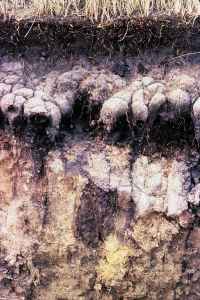
Solonetzic hardpan horizons restrict root and water penetration.
Courtesy of ARD
Test soil samples from the area suspected of having Solonetzic soils to ensure that the problem is correctly identified. If the soils are Solonetzic, the best option is to keep them under a permanent cover of trees, shrubs or pasture. If the land is in pasture, use a well managed rotational grazing system to avoid overgrazing.
If you wish to grow crops on these soils, consult an agronomist. Although deep plowing and subsoiling can make some Solonetzic soils more productive for cropping, not all Solonetzic soils benefit from these practices.
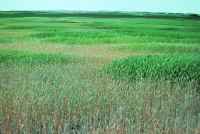
Irregular crop growth pattern to due to presence of Solonetzic soils.
Courtesy of ARD
Soil Compaction
The dense structure and low porosity of compacted soils restrict the growth of plant roots and limit the plant's ability to obtain water and nutrients.
To prevent or minimize soil compaction:
- Avoid field work when the soil is wet.
- Try to avoid driving over the same area repeatedly.
- Use practices that add organic matter to the soil (see Soil Organic Matter).
- Use tillage practices that minimize the disturbance of soil (see Tillage and Seeding Practices). Avoid the use of tillage implements that pulverize soils.
- Reduce axle weight and use flotation tires.
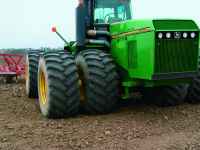
Use of flotation tires helps prevent or minimize soil compaction.
Courtesy of ARD
Marginal Crop Lands
Marginal crop lands are lands with characteristics that severely limit annual crop production. They include land that is very prone to erosion or flooding, land with steep slopes or rocky soils. For both economic and environmental reasons, these lands are better kept under some form of permanent cover such as perennial forages, pasture or trees.
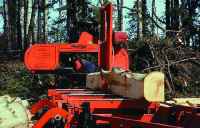
Well managed woodlots provide a diversity of timber products.
Courtesy of Agriculture and Agri-Food Canada - PFRA
Before you remove natural permanent cover from an area, contact an agronomist for technical assistance in determining the agricultural potential of the land. It may be more profitable to leave the land with its natural cover.
If an attempt has already been made to convert marginal lands to annual crop production, it is best to replant them to a form of permanent cover.
Back to Chapter 3 - Cropping Practices |
|